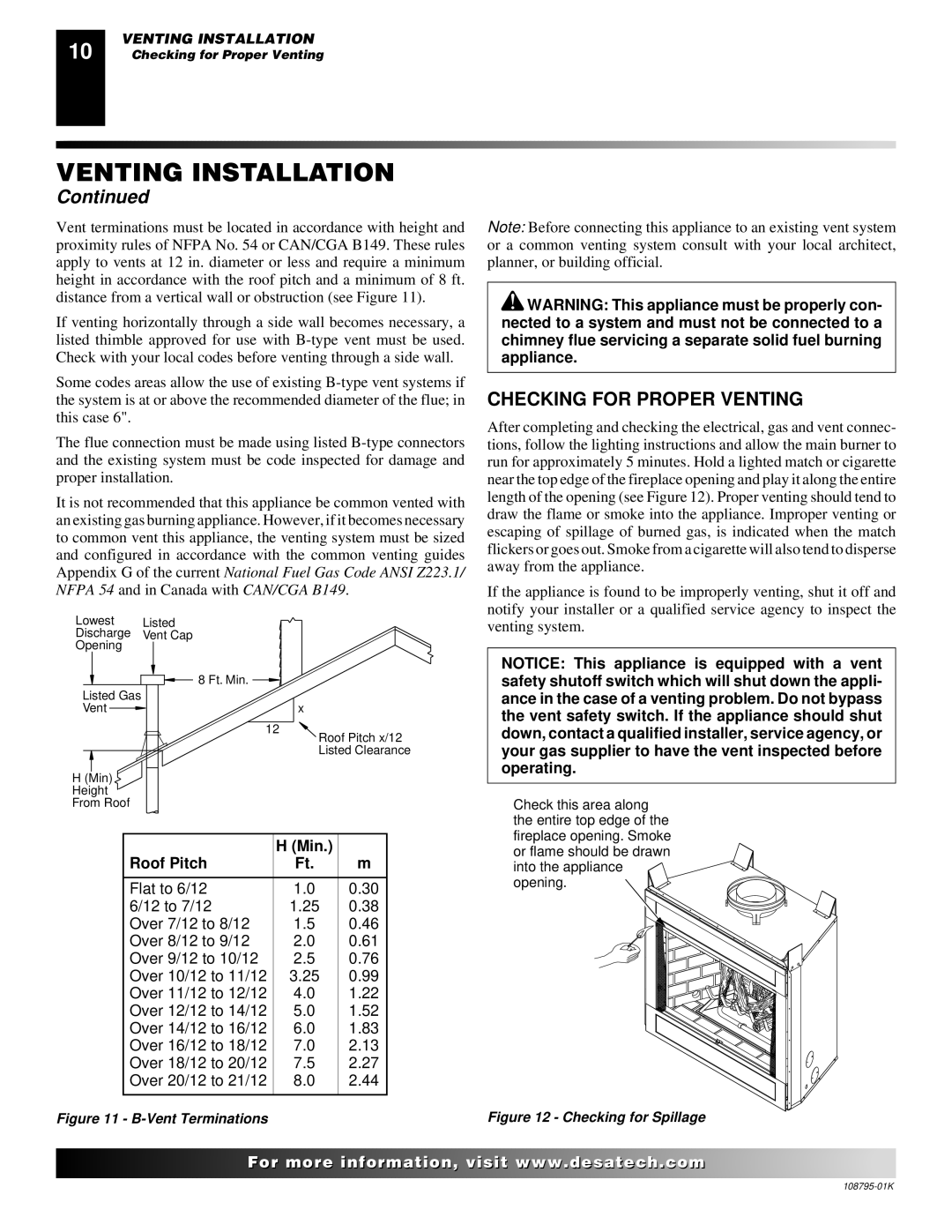
10
VENTING INSTALLATION
Checking for Proper Venting
VENTING INSTALLATION
Continued
Vent terminations must be located in accordance with height and proximity rules of NFPA No. 54 or CAN/CGA B149. These rules apply to vents at 12 in. diameter or less and require a minimum height in accordance with the roof pitch and a minimum of 8 ft. distance from a vertical wall or obstruction (see Figure 11).
If venting horizontally through a side wall becomes necessary, a listed thimble approved for use with
Some codes areas allow the use of existing
The flue connection must be made using listed
It is not recommended that this appliance be common vented with an existing gas burning appliance. However, if it becomes necessary to common vent this appliance, the venting system must be sized and configured in accordance with the common venting guides Appendix G of the current National Fuel Gas Code ANSI Z223.1/ NFPA 54 and in Canada with CAN/CGA B149.
Note: Before connecting this appliance to an existing vent system or a common venting system consult with your local architect, planner, or building official.
![]() WARNING: This appliance must be properly con- nected to a system and must not be connected to a chimney flue servicing a separate solid fuel burning appliance.
WARNING: This appliance must be properly con- nected to a system and must not be connected to a chimney flue servicing a separate solid fuel burning appliance.
CHECKING FOR PROPER VENTING
After completing and checking the electrical, gas and vent connec- tions, follow the lighting instructions and allow the main burner to run for approximately 5 minutes. Hold a lighted match or cigarette near the top edge of the fireplace opening and play it along the entire length of the opening (see Figure 12). Proper venting should tend to draw the flame or smoke into the appliance. Improper venting or escaping of spillage of burned gas, is indicated when the match flickers or goes out. Smoke from a cigarette will also tend to disperse away from the appliance.
If the appliance is found to be improperly venting, shut it off and notify your installer or a qualified service agency to inspect the
Lowest Listed
Discharge Vent Cap
Opening
![]() 8 Ft. Min.
8 Ft. Min. ![]()
Listed Gas
Vent ![]()
12
H(Min) Height From Roof
x
Roof Pitch x/12 Listed Clearance
venting system.
NOTICE: This appliance is equipped with a vent safety shutoff switch which will shut down the appli- ance in the case of a venting problem. Do not bypass the vent safety switch. If the appliance should shut down, contact a qualified installer, service agency, or your gas supplier to have the vent inspected before operating.
Check this area along the entire top edge of the
| H (Min.) |
|
Roof Pitch | Ft. | m |
|
|
|
Flat to 6/12 | 1.0 | 0.30 |
6/12 to 7/12 | 1.25 | 0.38 |
Over 7/12 to 8/12 | 1.5 | 0.46 |
Over 8/12 to 9/12 | 2.0 | 0.61 |
Over 9/12 to 10/12 | 2.5 | 0.76 |
Over 10/12 to 11/12 | 3.25 | 0.99 |
Over 11/12 to 12/12 | 4.0 | 1.22 |
Over 12/12 to 14/12 | 5.0 | 1.52 |
Over 14/12 to 16/12 | 6.0 | 1.83 |
Over 16/12 to 18/12 | 7.0 | 2.13 |
Over 18/12 to 20/12 | 7.5 | 2.27 |
Over 20/12 to 21/12 | 8.0 | 2.44 |
|
|
|
Figure 11 - B-Vent Terminations
fireplace opening. Smoke or flame should be drawn into the appliance opening.
Figure 12 - Checking for Spillage
![]()
![]()
![]()
![]()
![]()
![]()
![]() For more
For more![]()
![]()
![]()
![]()
![]() visit www.
visit www.![]()
![]()
![]() .com
.com![]()
![]()
![]()
![]()
![]()
![]()
![]()
